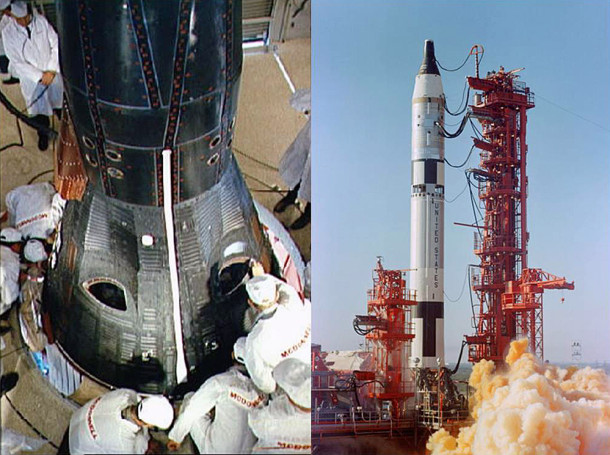
Fifty years ago this week, Gemini III was launched into Earth orbit with astronauts Vigil I. “Gus” Grissom and John W. Young onboard. The 3-orbit mission marked the first time that the United States flew a multi-man spacecraft.
Project Mercury was America’s first manned spaceflight series. Project Apollo would ultimately land men on the Moon and return them safely to the Earth. In between these historic spaceflight efforts would be Project Gemini.
The purpose of Project Gemini was to develop and flight-prove a myriad of technologies required to get to the Moon. Those technologies included spacecraft power systems, rendezvous and docking, orbital maneuvering, long duration spaceflight and extravehicular activity.
The Gemini spacecraft weighed 8,500 pounds at lift-off and measured 18.6 feet in length. Gemini consisted of a reentry module (RM), an adapter module (AM) and an equipment module (EM).
The crew occupied the RM which also contained navigation, communication, telemetry, electrical and reentry reaction control systems. The AM contained maneuver thrusters and the deboost rocket system. The EM included the spacecraft orbit attitude control thrusters and the fuel cell system. Both the AM and EM were used in orbit only and discarded prior to entry.
Gemini-Titan III (GT-3) lifted-off at 14:24 UTC from LC-19 at Cape Canaveral, Florida on Tuesday, 23 March 1965. The two-stage Titan II launch vehicle placed Gemini 3 into a 121 nautical mile x 87 nautical mile elliptical orbit.
Gemini 3’s primary objective was to put the maneuverable Gemini spacecraft through its paces. While in orbit, Grissom and Young fired thrusters to change the shape of their orbital flight path, shift their orbital plane, and dip down to a lower altitude. Gemini 3 was also the first time that a manned spacecraft used aerodynamic lift to change its entry flight path.
As spacecraft commander, Gus Grissom named his cosmic chariot The Molly Brown in reference to a then-popular Broadway show; “The Unsinkable Molly Brown”. Grissom chose the moniker in memory of his first spaceflight experience wherein his Liberty Bell 7 Mercury spacecraft sunk in almost 17,000 feet of water during post-splashdown operations.
At almost two (2) hours into the mission, pilot John Young presented Grissom with his favorite sandwich which had been smuggled onboard. Grissom and Young took a bite of the corned beef sandwich and put it away since loose crumbs could get into spacecraft electronics with catastrophic results. Not amused, NASA management reprimanded the crew after the mission.
Gemini 3 splashed-down in the Atlantic Ocean at 19:16:31 UTC following a 3 orbit mission. The spacecraft landed 45 nautical miles short of the intended splashdown point due to a misprediction of aerodynamic lift. Although hot and sea-sick, Commander Grissom refused to open the spacecraft hatches until the recovery ship USS Intrepid came on station.
Nine (9) additional Gemini space missions would follow the flight of Gemini 3. Indeed, the historical record shows that the Gemini Program would fly an average of every two (2) months by the time Gemini XII landed in December 1966. During that period, the United States would take the lead in the race to the Moon that it would never relinquish.

